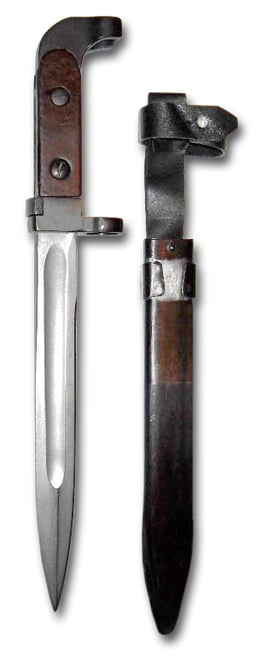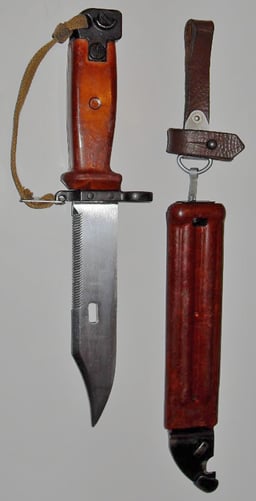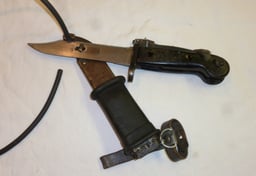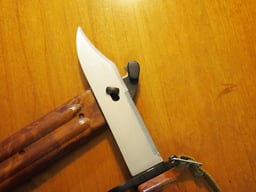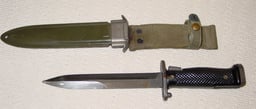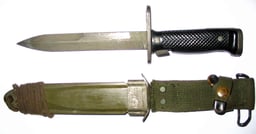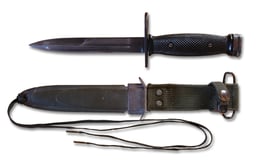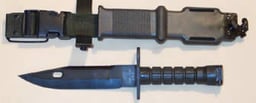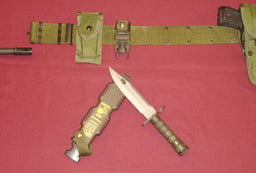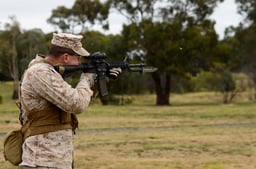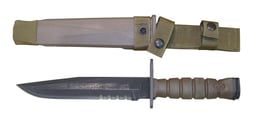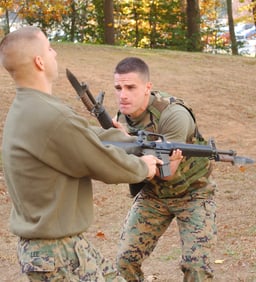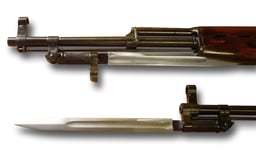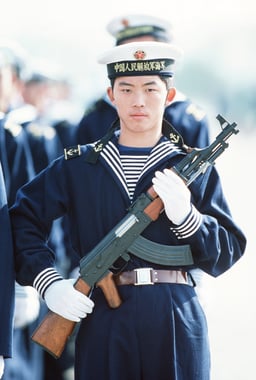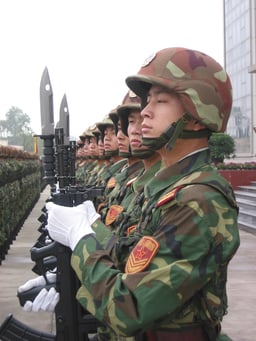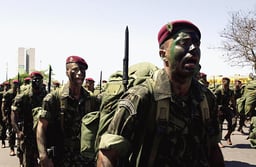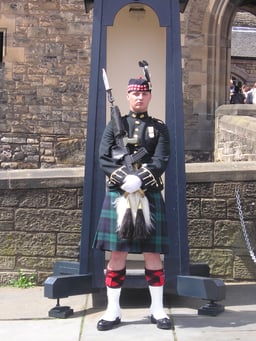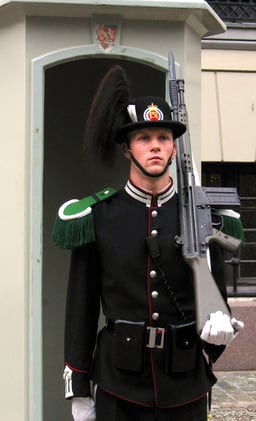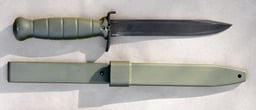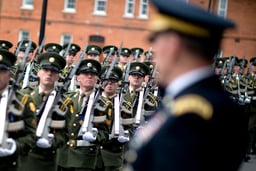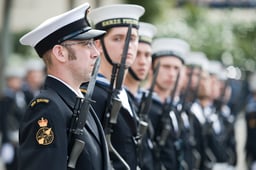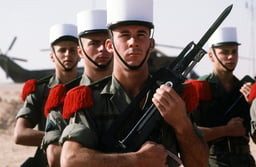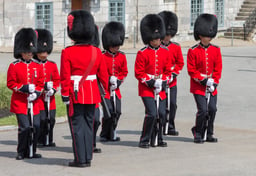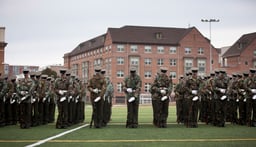Bayonet
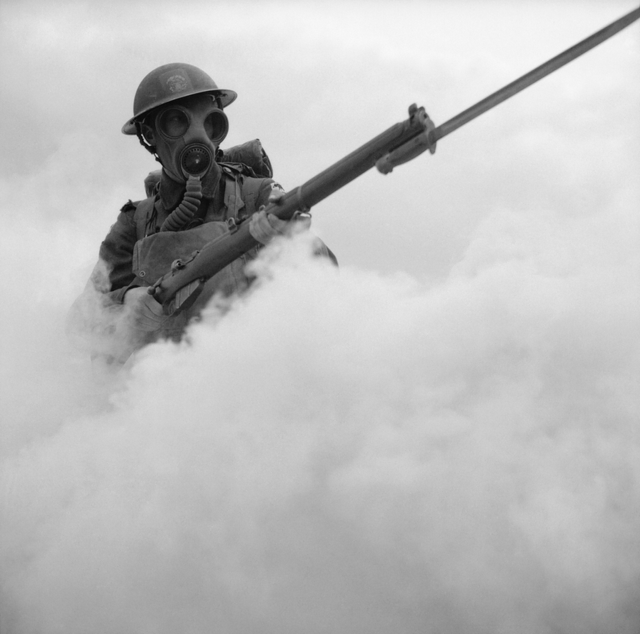
Bayonet
A bayonet (from French baïonnette) is a knife, sword, or spike-shaped weapon designed to fit on the end of the muzzle of a rifle, musket or similar firearm, allowing it to be used as a spear.[1] From the 17th century to World War I, it was considered the primary weapon for infantry attacks. Today, it is considered an ancillary weapon or a weapon of last resort.
History
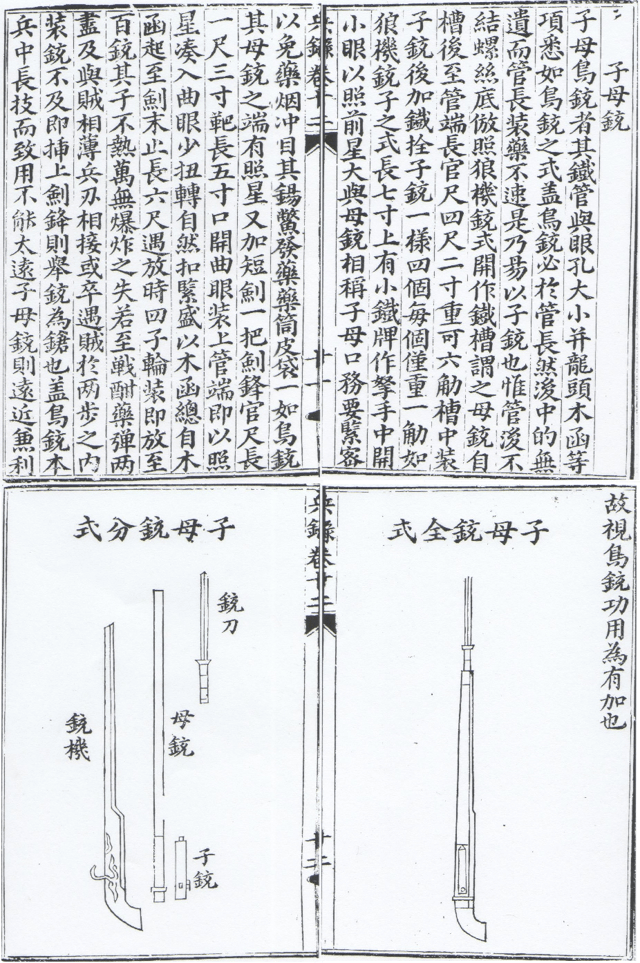
Depiction of a 16th century Chinese breech-loading musket with a plug bayonet attached.
The term bayonette itself dates back to the second half of the 16th century, but it is not clear whether bayonets at the time were knives that could be fitted to the ends of firearms, or simply a type of knife. For example, Cotgrave's 1611 Dictionarie describes the bayonet as "a kind of small flat pocket dagger, furnished with knives; or a great knife to hang at the girdle". Likewise, Pierre Borel wrote in 1655 that a kind of long-knife called a bayonette was made in Bayonne but does not give any further description.[2]
Plug bayonets
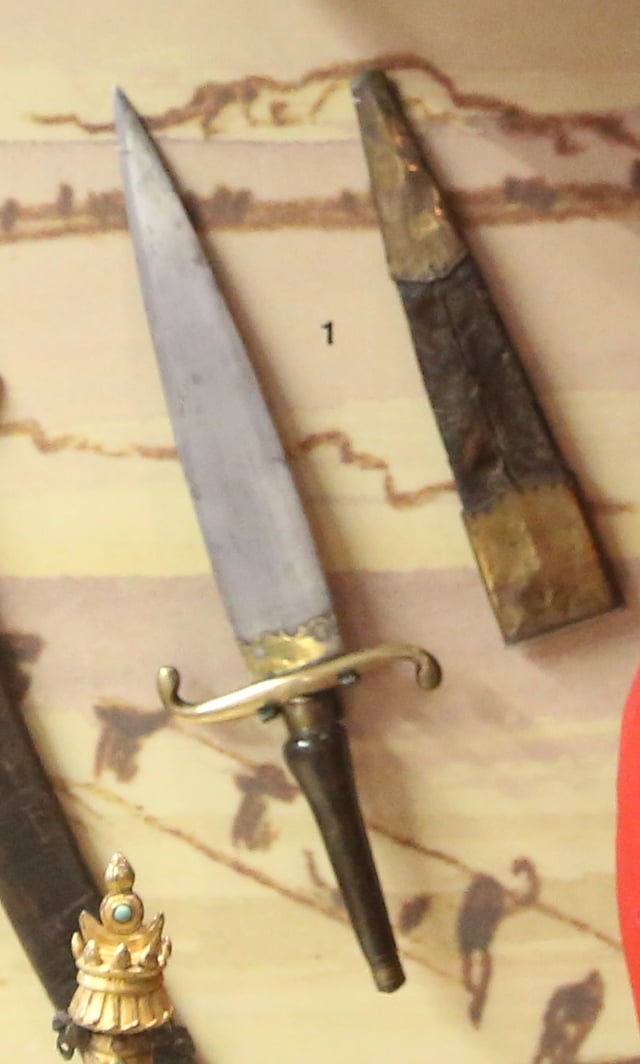
17th-century plug bayonet
The first recorded instance of a bayonet proper is found in the Chinese military treatise Binglu published in 1606.
It was in the form of the Son-and-mother gun, a breech-loading musket that was issued with a roughly 57.6 cm (22.7 in) long plug bayonet, giving it an overall length of 1.92 m (6 ft 4 in) with the bayonet attached. It was labelled as a "gun-blade" (traditional Chinese: 銃刀; simplified Chinese: 铳刀) with it being described as a "short sword that can be inserted into the barrel and secured by twisting it slightly" that it is to be used "when the battle have depleted both gunpowder and bullets as well as fighting against bandits, when forces are closing into melee or encountering an ambush" and if one "cannot load the gun within the time it takes to cover two bu (3.2 meters) of ground they are to attach the bayonet and hold it like a spear".[3][4]
Early bayonets were of the "plug" type, where the bayonet was fitted directly into the barrel of the musket.[5] This allowed light infantry to be converted to heavy infantry and hold off cavalry charges.
The bayonet had a round handle that slid directly into the musket barrel.
This naturally prevented the gun from being fired.
The first known mention of the use of bayonets in European warfare was in the memoirs of Jacques de Chastenet, Vicomte de Puységur. [6] He described the French using crude 1-foot (0.30 m) plug bayonets during the Thirty Years' War (1618–1648).[6] However, it was not until 1671 that General Jean Martinet standardized and issued plug bayonets to the French regiment of fusiliers then raised. They were issued to part of an English dragoon regiment raised in 1672, and to the Royal Fusiliers when raised in 1685.
Socket bayonets
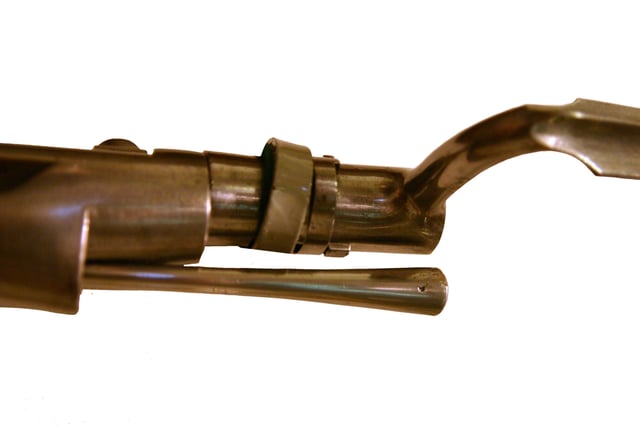
Socket of a bayonet
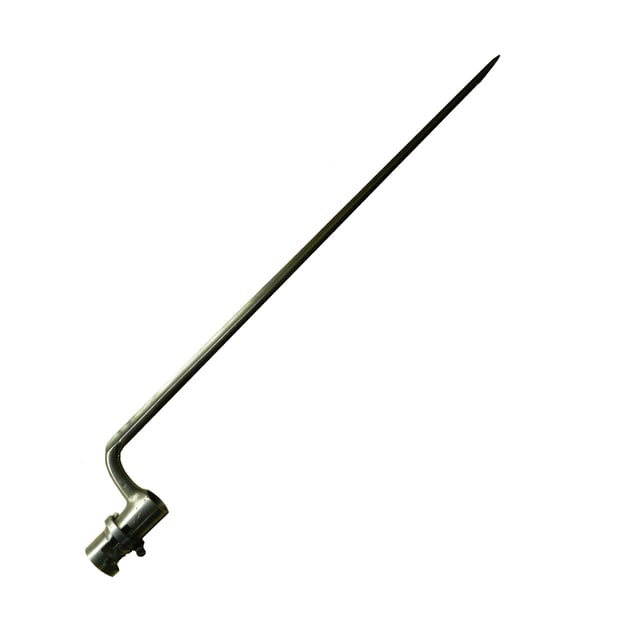
Early 19th-century offset spiked socket bayonet
The major problem with plug bayonets was that when attached they made it impossible to fire the musket, requiring soldiers to wait until the last possible moment before a melee to fixing bayonets. The defeat of forces loyal to William of Orange by Jacobite Highlanders at the Battle of Killiecrankie in 1689 was due (among other things) to the use of the plug bayonet.[5] The Highlanders closed to 50 metres, fired a single volley, dropped their muskets, and using axes and swords quickly overwhelmed the loyalists before they had time to fix bayonets. Shortly thereafter, the defeated leader, Hugh Mackay, is believed to have introduced a socket bayonet of his own invention. Soon "socket" bayonets would incorporate both socket mounts and an offset blade that fit around the musket's barrel, which allowed the musket to be fired and reloaded while the bayonet was attached.
An unsuccessful trial with socket or zigzag bayonets was made after the Battle of Fleurus in 1690, in the presence of King Louis XIV, who refused to adopt them, as they had a tendency to fall off the musket. Shortly after the Peace of Ryswick (1697), the English and Germans abolished the pike and introduced socket bayonets. The British socket bayonet had a triangular blade with a flat side towards the muzzle and two fluted sides outermost to a length of 15 inches (38 cm). However it had no lock to keep it fast to the muzzle and was well-documented for falling off in the heat of battle.[5]
By the 18th century, socket bayonets had been adopted by most European armies.
In 1703, the French infantry adopted a spring-loaded locking system that prevented the bayonet from accidentally separating from the musket.
A triangular blade was introduced around 1715 and was stronger than the previous single or double-edged models, creating wounds which were harder to treat due to the propensity of healing scar tissue to pull apart the triangular incision.
Sword bayonets

Baker Rifle with sword bayonet
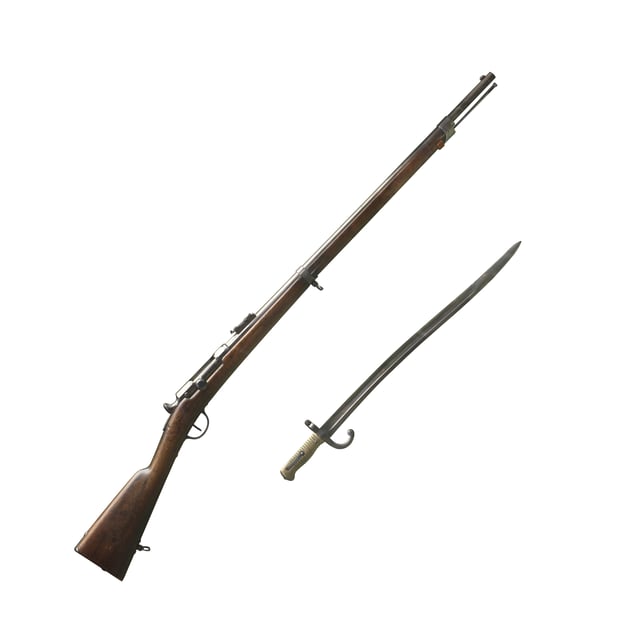
Chassepot bolt-action rifle and sword bayonet.
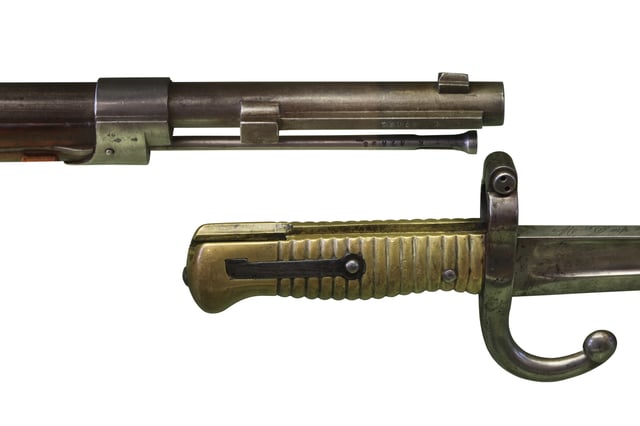
Bayonet assembly system of the Chassepot
The 19th century introduced the concept of the sword bayonet, a long-bladed weapon with a single- or double-edged blade that could also be used as a shortsword. Its initial purpose was to ensure that riflemen could form an infantry square properly to fend off cavalry attacks when in ranks with musketmen, whose weapons were longer. A prime early example of a sword bayonet-fitted rifle is the British Infantry Rifle of 1800–1840, later known as the "Baker Rifle". The hilt usually had quillons modified to accommodate the gun barrel and a hilt mechanism that enabled the bayonet to be attached to a bayonet lug. A sword bayonet could be used in combat as a side arm. When attached to the musket or rifle, it effectively turned almost any long gun into a spear or glaive, suitable not only for thrusting but also for slashing.
While the British Army eventually discarded the sword bayonet, the socket bayonet survived the introduction of the rifled musket into British service in 1854.
The new rifled musket copied the French locking ring system.[5] The new bayonet proved its worth at the Battle of Alma and the Battle of Inkerman during the Crimean War, where the Imperial Russian Army learned to fear it.[5]
From 1869, some European nations began to develop new bolt-action breechloading rifles (such as the Chassepot) and sword bayonets suitable for mass production and for use by police, pioneer, and engineer troops.[7] The decision to redesign the bayonet into a short sword was viewed by some as an acknowledgement of the decline in importance of the fixed bayonet as a weapon in the face of new advances in firearms technology.[8] As a British newspaper put it, "the committee, in recommending this new sword bayonet, appear to have had in view the fact that bayonets will henceforth be less frequently used than in former times as a weapon of offence and defence; they desired, therefore, to substitute an instrument of more general utility."[8]
Multipurpose bayonets
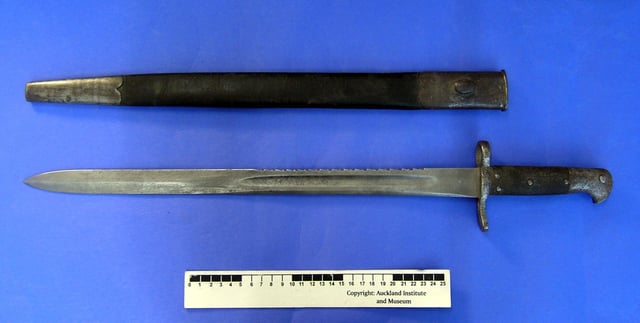
British Pattern 1875 Snider saw-backed bayonet (with scabbard) for Artillery Carbine

U.S. BAYONET MODEL 1873 TROWEL
One of these multipurpose designs was the 'sawback' bayonet, which incorporated saw teeth on the spine of the blade.[7] The sawback bayonet was intended for use as a general-purpose utility tool as well as a weapon; the teeth were meant to facilitate the cutting of wood for various defensive works such as barbed-wire posts, as well as for butchering livestock.[1]Bayonets%3A%20An%20Illustrated%20History]][9]Knight's%20American%20Mechanical%20D]] latter introduced their last model in 1914).[1]Bayonets%3A%20An%20Illustrated%20History]][9]Knight's%20American%20Mechanical%20D]][11]S]]al saw. The sawback proved relatively ineffective as a cutting tool, and was soon outmoded by improvements in military logistics and transportation; most nations dropped the sawback feature by 1900.[[1]](https://openlibrary.org/search?q=Brayley%2C%20Martin%2C%20 [[CITE|1|https://openlibrary.org/search?q=Brayley%2C%20Martin%2C%20*Bayonets%3A%20An%20Illustrated%20History) e of the sawback bayonet in 1917 after protests that the serrated blade caused unnecessarily severe wounds when used as a fixed bayonet.
The trowel or spade bayonet was another multipurpose design, intended for use both as an offensive weapon as well as a digging tool for excavating entrenchments.[12][13] From 1870, the US Army issued trowel bayonets to infantry regiments based on a design by Lieutenant-Colonel Edmund Rice, a US Army officer and Civil War veteran, which were manufactured by the Springfield Armory.[14] Besides its utility as both a fixed bayonet and a digging implement, the Rice trowel bayonet could be used to plaster log huts and stone chimneys for winter quarters; sharpened on one edge, it could cut tent poles and pins.[14]*Trowel-Bayonet%2C%20Letter%20from%20]][15][15]Uniforms%2C%20Arms%2C%20and%20Equi]] sic r use has passed."[14]*Trowel-Bayonet%2C%20Letter%20from%20]]*he Rice trowel bayonet was declared obsolete by the US Army in December 1881.
"Reach" controversy
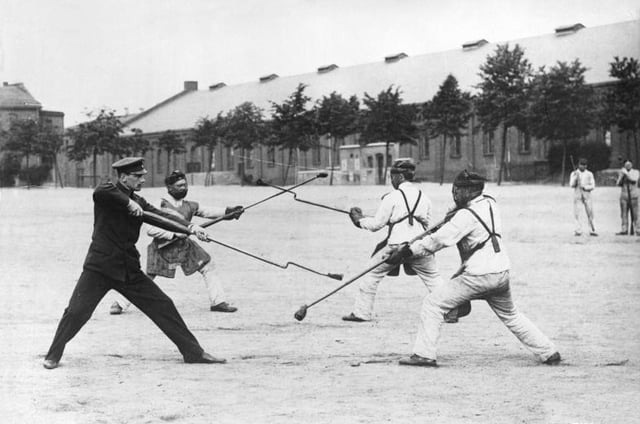
German soldiers at bayonet practice in 1914
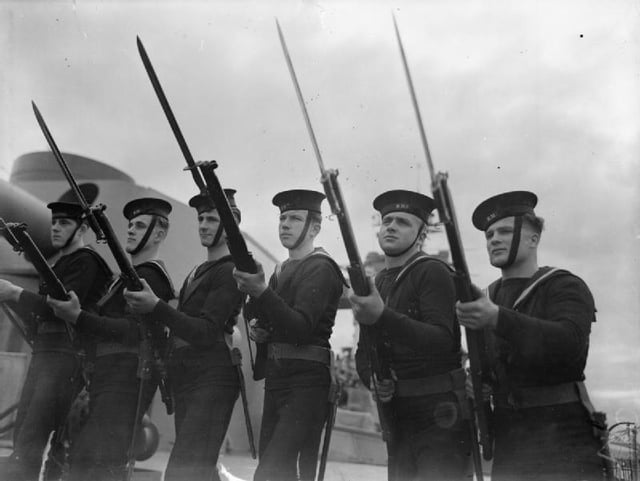
Six sailors with Lee–Enfield rifles, standing in the 'On Guard' position during rifle and bayonet drill on board the Battleship HMS RODNEY.
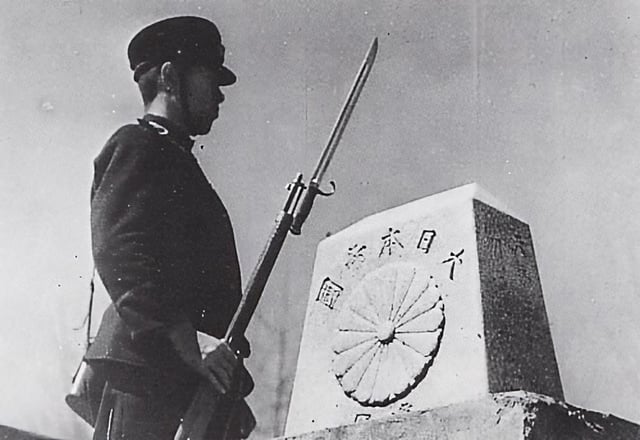
From 1899 to the end of the Pacific War, the Japanese used the very long, 15.75 inches (25.4 cm), Type 30 sword-bladed bayonet on the already very long Arisaka rifle.
Prior to World War I, bayonet doctrine was largely founded upon the concept of "reach"; that is, a soldier's theoretical ability, by use of an extremely long rifle and fixed bayonet, to stab an enemy soldier without having to approach within reach of his opponent's blade.[1]Bayonets%3A%20An%20Illustrated%20History]][17] like the infantryman's pike of bygone days, was thought to impart a definite tactical advantage on the battlefield, and military authorities engaged in endless discussions over the supposed advantages of longer rifle/bayonet combinations.[1]Bayonets%3A%20An%20Illustrated%20History]] [17][19]
In 1886, the French Army introduced a 52-centimetre-long (20.5 in) quadrangular épée spike for the bayonet of the Lebel Model 1886 rifle, the Épée-Baïonnette Modèle 1886, resulting in a rifle and bayonet with an overall length of six feet (1.8 m). German ordnance authorities responded by introducing a long sword bayonet for the Model 1898 Mauser rifle, which had a 29-inch barrel. The new bayonet, designated the Seitengewehr 98, had a 50 cm (19.7-inch) blade.[18]*Scientific%20American%20War%20Book%3A]]*ith an overall length of 5 feet 9 inches (1.75 m), the German Army's rifle/bayonet combination was second only to the French Lebel for overall bayonet 'reach'.
After 1900, Switzerland, Britain, and the United States adopted rifles with barrel lengths shorter than that of a rifled musket, but longer than that of a carbine.[1]Bayonets%3A%20An%20Illustrated%20History]][20]*Encyclop%C3%A6dia%20Br]]*e to the reduction in barrel length, the overall "reach" of the new short rifles with attached bayonet was reduced.Lee–Enfield SMLE[1]Bayonets%3A%20An%20Illustrated%20History]] [1]*Bayonets%3A%20An%20Illustrated%20History]]]]ing the effective reach of the new short rifles when equipped with a fixed bayonet.[1]*Bayonets%3A%20An%20Illustrated%20History]][20]*Encyclop%C3%A6dia%20Br]]
In 1905 the German Army adopted a shortened 37-centimetre-long (14.5 in) bayonet, the Seitengewehr 98/06 for engineer and pioneer troops, and in 1908, a short rifle as well, the Karabiner Model 1898AZ, which was produced in limited quantities for the cavalry, artillery, and other specialist troops.[23] However, the long-barreled 98 Mauser rifle remained in service as the primary infantry small arm.[24] Moreover, German military authorities continued to promote the idea of outreaching one's opponent on the battlefield by means of a longer rifle/bayonet combination, a concept prominently featured in its infantry bayonet training doctrines.[19] These included the throw point or extended thrust-and-lunge attack.[25]*Popu]]sing this tactic, the German soldier dropped into a half-crouch, with the rifle and fixed bayonet held close to the body. rd with the right foot, simultaneously thrusting out the right arm to full length with the extended rifle held in the grip of the right hand alone.[25]Popu]]With a maximum 'kill zone' of some eleven feet, theointbayonet attack gave an impressive increase in 'reach', and was later adopted by other military forces, including the U.S. Army.[26]
In response to criticism over the reduced reach of the SMLE rifle and bayonet, British ordnance authorities introduced the P1907 bayonet in 1908, which had an elongated blade of some seventeen inches to compensate for the reduced overall length of the SMLE rifle.[1]Bayonets%3A%20An%20Illustrated%20History]][17][27]%2C]] [29]. blade) bayonet for the M1903 Springfield short rifle, the M1905 bayonet; later, a long sword bayonet was also provided for the M1917 Enfield rifle.[22]
Reversal in opinion

US military bayonets; from the top down, they are the M1905, the M1, M1905E1 Bowie Point Bayonet (a cut down version of the M1905), and the M4 Bayonet for the M1 Carbine.
The experience of World War I prompted a complete reversal in opinion on the relative value of long rifles and bayonets in typical infantry combat operations.[21][28]*Weapon%3A%20A%20Visual%20History%20of%20A]]%2C%20Pla]]onet when used as a close-quarters battle weapon.[21][28]Weapon%3A%20A%20Visual%20History%20of%20A]]%2C%20Pla]]hrow pointextended thrust-and-lunge attack[25] r to a return thrust which he could not easily block or parry.[25]Popu]]%2C]] trench knife pistol hand grenade entrenching tool CITE|30|https://openlibrary.org/search?q=McBride%2C%20Herbert%20W.%2C%20A%20Rifleman%20Went%20to%20War%2C%20Pla]][34]
Soldiers soon began employing the bayonet as a knife as well as an attachment for the rifle, and bayonets were often shortened officially or unofficially to make them more versatile and easier to use as tools, or to maneuver in close quarters.[1]Bayonets%3A%20An%20Illustrated%20History]] [30][31][1][1]
Bayonet charge
The development of the bayonet in the late 17th century led to the bayonet charge becoming the main infantry tactic through the 19th century and into the 20th. As early as the 19th century, military scholars were already noting that most bayonet charges did not result in close combat. Instead, one side usually fled before actual bayonet fighting ensued. The act of fixing bayonets has been held to be primarily connected to morale, the making of a clear signal to friend and foe of a willingness to kill at close quarters.[35]
Napoleonic wars
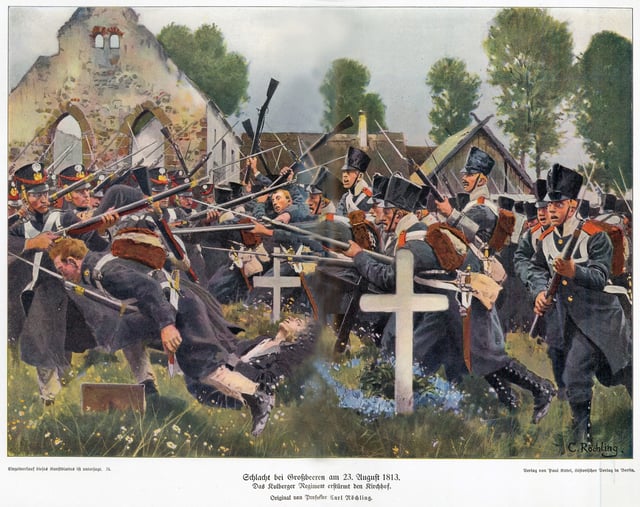
A bayonet charge during the Battle of Großbeeren (1813)
The bayonet charge was a common tactic used during the Napoleonic wars. Despite its effectiveness, a bayonet charge did not necessarily cause substantial casualties through the use of the weapon itself. Detailed battle casualty lists from the 18th century showed that in many battles, fewer than 2% of all wounds treated were caused by bayonets.[36] Antoine-Henri Jomini, a celebrated military author who served in numerous armies during the Napoleonic period, stated that the majority of bayonet charges in the open resulted with one side fleeing before any contact was made. Combat with bayonets did occur, but mostly on a small scale when units of opposing sides encountered each other in a confined environment, such as during the storming of fortifications or during ambush skirmishes in broken terrain.[37] In an age of fire by massed volley, when compared to random unseen bullets, the threat of the bayonet was much more tangible and immediate – guaranteed to lead to a personal gruesome conclusion if both sides persisted. All this encouraged men to flee before the lines met. Thus, the bayonet was an immensely useful weapon for capturing ground from the enemy, despite seldom actually being used to inflict wounds.
American Civil War
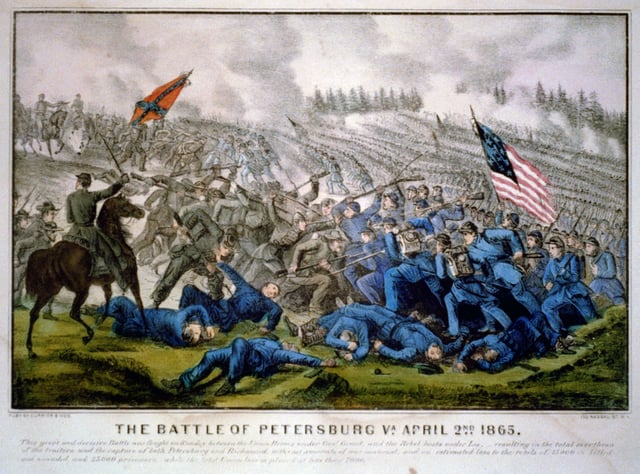
A bayonet charge during the American Civil War
During the American Civil War (1861–1865) the bayonet was found to be responsible for less than 1% of battlefield casualties,[38] a hallmark of modern warfare. The use of bayonet charges to force the enemy to retreat was very successful in numerous small unit engagements at short range in the American Civil War, as most troops would retreat when charged while reloading (which could take up to a minute with loose powder even for trained troops). Although such charges inflicted few casualties, they often decided short engagements, and tactical possession of important defensive ground features. Additionally, bayonet drill could be used to rally men temporarily discomfited by enemy fire.[39]
While the overall Battle of Gettysburg was won by the Union armies due to a combination of terrain and massed artillery fire, a decisive point on the second day of the battle hinged on a bayonet charge at Little Round Top when the 20th Maine Volunteer Infantry Regiment, running short of musket ammunition, charged downhill, surprising and capturing many of the surviving soldiers of the 15th Alabama and other Confederate regiments.
Going over the top
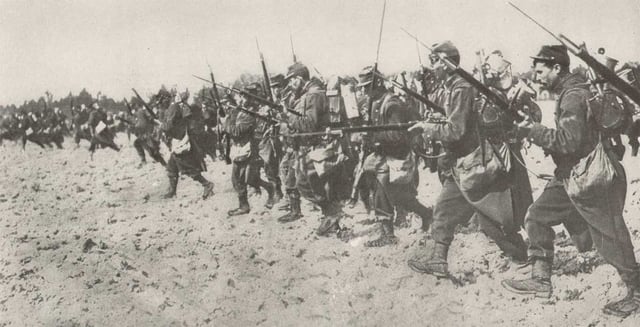
French infantry bayonet charge during the First World War.
The popular image of a World War I combat is of a wave of soldiers with bayonets fixed, "going over the top" and charging across no man's land into a hail of enemy fire. Although this was the standard method of fighting early in the war, it was rarely successful. British casualties on the first day of the Battle of the Somme were the worst in the history of the British army, with 57,470 British casualties, 19,240 of whom were killed.[40][41]
During World War I, no man's land was often hundreds of yards across.[42] The area was usually devastated by the warfare and riddled with craters from artillery and mortar shells, and sometimes contaminated by chemical weapons. Heavily defended by machine guns, mortars, artillery and riflemen on both sides, it was often covered with barbed wire and land mines, and littered with the rotting corpses of those who were not able to make it across the sea of bullets, explosions and flames. A bayonet charge through no man's land often resulted in the total annihilation of entire battalions.
Banzai charges
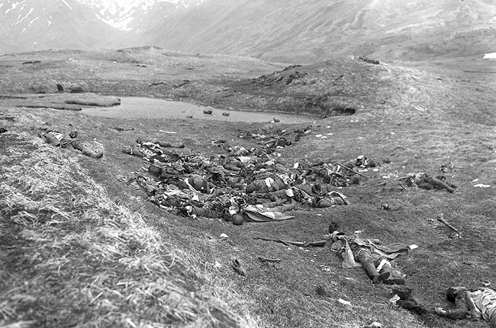
Dead Japanese troops lie where they fell on Attu Island after a final banzai charge against American forces on May 29, 1943 during the Battle of Attu.
The advent of modern warfare in the 20th century made bayonet charges dubious affairs.
During the Siege of Port Arthur, the Japanese used suicidal human wave attacks against Russian artillery and machine guns,[43] suffering massive casualties.[44] One description of the aftermath was that a "thick, unbroken mass of corpses covered the cold earth like a [carpet]".[45]
However, during the Second Sino-Japanese War, the Japanese were able to effectively use bayonet charges against poorly organized and lightly armed Chinese troops. "Banzai charges" became an accepted military tactic where Japanese forces were able to routinely rout larger Chinese forces.[46]
In the early stages of the Pacific War, a sudden banzai charge might overwhelm small groups of enemy soldiers unprepared for such an attack. But, by the end of the war, against well organized and heavily armed American forces, a banzai charge inflicted little damage while its participants suffered horrendous losses. At best, they were conducted as a last resort by small groups of surviving soldiers when the main battle was already lost. At worst, they threw away valuable resources in men and arms in suicidal attacks, which only hastened defeat.
Human wave attack
The term "human wave attack" was often misused to describe the Chinese short attack [49] — a combination of infiltration and the shock tactics employed by the PLA during the Korean War.[50] A typical Chinese short attack was carried out at night by sending successive series small five-men fireteams to attack the weakest point of an enemy's defenses.[50] The Chinese assault team would crawl undetected within grenade range, then launch surprise attacks with fixed bayonets against the defenders in order to breach the defenses by relying on maximum shock and confusion.[50]
If the initial shock failed to breach the defenses, additional fireteams would press on behind them and attack the same point until a breach was created.[50] Once penetration was achieved, the bulk of the Chinese forces would move into the enemy rear and attack from behind.[51] Due to primitive communication systems and tight political controls within the Chinese army, short attacks were often repeated until either the defenses were penetrated or the attackers were completely annihilated.[50]
This persistent attack pattern left a strong impression on UN forces that fought in Korea, giving birth to the description of "human wave".[52] The term "human wave" was later used by journalists and military officials to convey the image of the American soldiers being assaulted by overwhelming numbers of Chinese on a broad front, which is inaccurate when compared with the normal Chinese practice of sending successive series of small teams against a weak points of the line.[53] It was in fact rare for the Chinese to actually use densely concentrated infantry formations to absorb enemy firepower.[54]
Last hurrahs
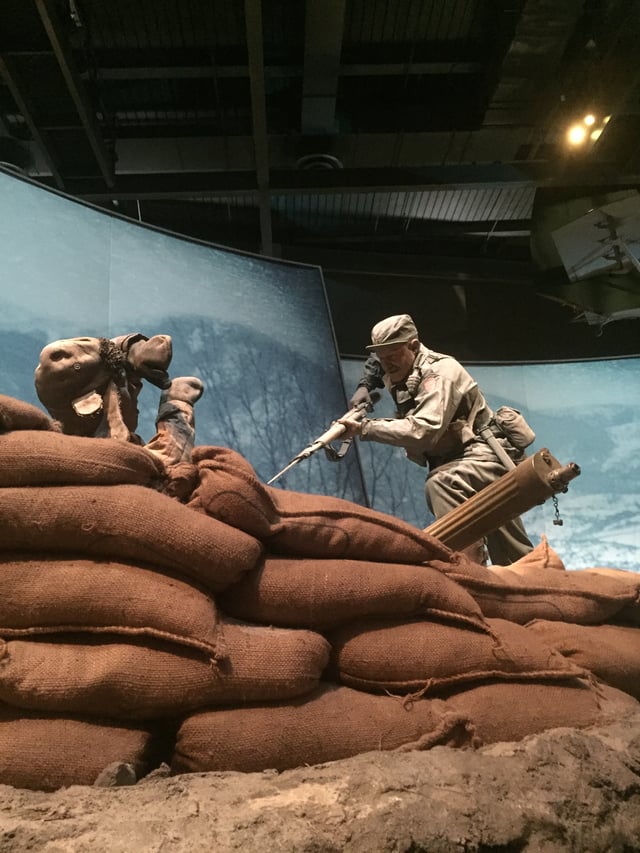
A life size diorama at the US Army Infantry Museum, Ft.
During the Korean War, the French Battalion and Turkish Brigade were not averse to using bayonet charges against their enemy.[55]
United States Army officer Lewis L. Millett led soldiers of the US Army's 27th Infantry Regiment in taking out a machine gun position with bayonets. Historian S.L.A. Marshall described the attack as "the most complete bayonet charge by American troops since Cold Harbor". Out of about 50 enemy dead, roughly 20 were found to have been killed by bayonets, and the location subsequently became known as Bayonet Hill.[56] This was the last bayonet charge by the US Army. For his leadership during the assault, Millett was awarded the Medal of Honor. The medal was formally presented to him by President Harry S. Truman in July 1951.[57] He was also awarded the Army's second-highest decoration, the Distinguished Service Cross, for leading another bayonet charge in the same month.[58]
In 1982, the British Army 2nd Battalion, Scots Guards mounted bayonet charges during the Falklands War at the Battle of Mount Tumbledown. For the courage displayed in the attack, they were awarded one Distinguished Service Order, two Military Crosses, two Distinguished Conduct Medals (one posthumously) and two Military Medals. Men from 9 Para Squadron, Royal Engineers, were awarded two Military Medals and Captain Sam Drennan, the Army Air Corps Scout pilot who had picked up the injured soldiers under fire and a former Scots Guards NCO, received the Distinguished Flying Cross.
In 1995, during the Siege of Sarajevo, French Marine infantrymen from the 3rd Marine Infantry Regiment carried out a bayonet charge against the Serbian forces at the Battle of Vrbanja bridge.[59] Actions led by the regiment allowed the United Nations blue helmets to exit from a passive position due to a first time engagement in hostile responses. Two casualties resulted from this event with seventeen others wounded.
During the Second Gulf War, and the war in Afghanistan the British Army units mounted bayonet charges.[60] In 2004 in Iraq at the Battle of Danny Boy, the Argyll and Sutherland Highlanders bayonet-charged mortar positions filled with over 100 Mahdi Army members. The ensuing hand-to-hand fighting resulted in an estimate of over 40 insurgents killed and 35 bodies collected (many floated down the river) and nine prisoners. Sergeant Brian Wood, of the Princess of Wales's Royal Regiment, was awarded the Military Cross for his part in the battle.[61]
In 2009, Lieutenant James Adamson, of the Royal Regiment of Scotland was awarded the Military Cross for a bayonet charge while on a tour of duty in Afghanistan: after shooting one Taliban fighter dead, Adamson had run out of ammunition when another enemy appeared. He immediately charged the second Taliban fighter and bayoneted him.[62] In September 2012, Lance Corporal Sean Jones of The Princess of Wales's Regiment was awarded the Military Cross for his role in a bayonet charge which took place in October 2011.[63]
Contemporary bayonets
Today the bayonet is rarely used in one-to-one combat.[64][65][66] Despite its limitations, many modern assault rifles (including bullpup designs) retain a bayonet lug and the bayonet is still issued by many armies. The bayonet is still used for controlling prisoners, or as a weapon of last resort.[64] In addition, some authorities have concluded that the bayonet serves as a useful training aid in building morale and increasing desired aggressiveness in troops.[67][68]
Russian Federation
The original AK-47 has an adequate but unremarkable bayonet. However, the AKM Type I bayonet (introduced in 1959) was a revolutionary design.[71] It has a Bowie style (clip-point) blade with saw-teeth along the spine, and can be used as a multi-purpose survival knife and wire-cutter when combined with its steel scabbard.[71][72] This design was copied by other nations and formed the basis of the US M9 bayonet.[71][73] The AK-74 bayonet 6Kh5 (introduced in 1983) represents a further refinement of the AKM bayonet. "It introduced a radical blade cross-section, that has a flat milled on one side near the edge and a corresponding flat milled on the opposite side near the false edge."[71] The blade has a new spear point and an improved one-piece moulded plastic grip, making it a more effective fighting knife.[71] It also has saw-teeth on the false edge and the usual hole for use as a wire-cutter.[71] The wire cutting versions of the AK bayonets each have an electrically insulated handle and an electrically insulated part of the scabbard, so it can be used to cut an electrified wire.
United States
The American M16 rifle used the M7 bayonet which is based on earlier designs such as the M4, M5 and M6 models, all of which are direct descendants of the M3 Fighting Knife and have a spear-point blade with a half sharpened secondary edge. The newer M9 has a clip-point blade with saw-teeth along the spine, and can be used as a multi-purpose knife and wire-cutter when combined with its scabbard. It can even be used by troops to cut their way free through the relatively thin metal skin of a crashed helicopter or airplane. The current USMC OKC-3S bayonet bears a resemblance to the Marines' iconic Ka-Bar fighting knife with serrations near the handle.
People's Republic of China
Belgium
The FN FAL has two types of bayonet. The first is a traditional spear point bayonet. The second is the Type C socket bayonet introduced in the 1960s.[76] It has a hollow handle that fits over the muzzle and slots that lined up with those on the FALs 22 mm NATO-spec flash hider.[76] Its spear-type blade is offset to the side of the handle to allow the bullet to pass beside the blade.[76]
United Kingdom
The current British L3A1 socket bayonet is based on the FN FAL Type C socket bayonet with a clip-point blade.[77] It has a hollow handle that fits over the SA80/L85 rifle's muzzle and slots that lined up with those on the flash eliminator. The blade is offset to the side of the handle to allow the bullet to pass beside the blade. It can also be used as a multi-purpose knife and wire-cutter when combined with its scabbard.[64] The scabbard also has a sharpening stone and folding saw blade.[64]
Germany
The H&K G3 rifle uses two types of bayonets, both of which mount above the G3's barrel.[78] The first is the standard G3 bayonet which has a blade similar to the American M7.[78] The second is an EICKHORN KCB-70 type multi-purpose knife bayonet, featuring a clip-point with saw-back, a wire-cutter scabbard and a distinctive squared handgrip.[78] For the H&K G36 there was little use of modified AKM type II blade bayonets from stocks of the former Nationale Volksarmee (National People's Army) of East Germany. The original muzzle-ring was cut away and a new, large diameter muzzle ring welded in place. The original leather belt hanger was replaced by a complex web and plastic belt hanger designed to fit the West German load bearing equipment.[79]
Austria
The Steyr AUG uses two types of bayonet. The first and most common is an Eickhorn KCB-70 type multi-purpose bayonet with an M16 bayonet type interface. The second are the Glock Feldmesser 78 (Field Knife 78) and the Feldmesser 81 (Survival Knife 81), which can also be used as a bayonet, by engaging a socket in the pommel (covered by a plastic cap) into a bayonet adapter that can be fitted to the AUG rifle.[80][81][82] These bayonets are noteworthy, as they were meant to be used primarily as field or survival knives and use as a bayonet was a secondary consideration. They can also be used as throwing knives and have a built-in bottle opener in the crossguard.[69][70]
France
The French use a more traditional spear point bayonet with the current FAMAS bayonet which is nearly identical to that of the M1949/56 bayonet.[83] The new French H&K 416 F rifle uses the Eickhorn "SG 2000 WC-F" a "tantō"-style multi-purpose combat knife/bayonet (similar to the KM2000) with a wire cutter.[84] It weighs 320 g (0.7 lb), is 30.0 cm (11.8 in) long with half serrated 17.3 cm (6.8 in) blade for cutting through ropes.[84] The synthetic handle and sheath have electrical insulation that protects up to 10.000 volts. The sheath also has a diamond blade sharpener.
Photo gallery
Linguistic impact
The push-twist motion of fastening the older type of bayonet has given a name to:
The "bayonet mount" used for various types of quick fastenings, such as camera lenses.
Several connectors and contacts including the bayonet-fitting light bulb that is common in the UK (as opposed to the continental European screw-fitting type).
The BNC ("Bayonet Neill-Concelman") RF connector.
One type of connector for foil and sabre weapons used in modern fencing competitions is referred to as a "bayonet" connector.
In chess, an aggressive variation of the King's Indian Defence is known as the "Bayonet Attack".
The bayonet has become a symbol of military power.
The term "at the point of a bayonet" refers to using military force or action to accomplish, maintain, or defend something (cf.
Bayonet Constitution). Undertaking a task "with fixed bayonets" has this connotation of no room for compromise and is a phrase used particularly in politics.
Badges and insignias
The Australian Army 'Rising Sun' badge features a semicircle of bayonets. The Australian Army Infantry Combat Badge (ICB) takes the form of a vertically mounted Australian Army SLR (7.62mm self-loading rifle FN FAL) bayonet surrounded by an oval-shaped laurel wreath.[85] The US Army Combat Action Badge, awarded to personnel who have come under fire since 2001 and who are not eligible for the Combat Infantryman Badge (due to the fact that only Infantry personnel may be awarded the Combat Infantryman Badge), has a bayonet as its central motif.
The shoulder sleeve insignia for the 10th Mountain Division in the US Army features crossed bayonets. The US Army's 173rd Airborne Brigade Combat Team's shoulder patch features a bayonet wrapped in a wing, symbolizing their airborne status. The brigade regularly deploys in task forces under the name "Bayonet". The insignia of the British Army's School of Infantry is an SA80 bayonet against a red shield. It is worn as a Tactical recognition flash (TRF) by instructors at the Infantry Training Centre Catterick, the Infantry Battle School at Brecon and the Support Weapons School in Warminster.
The vocation tab collar insignia for the Singapore Armed Forces Infantry Formation utilizes two crossed bayonets.
The bayonet is often used as a symbol of the Infantry in Singapore.
See also
Bayonet Constitution
Combatives
Jūkendō
Aiki-jō wooden staff used in the japanese martial art of Aikido, which usage resembles a bayonet more than a spear.
Bayonet lug
Spike bayonet
Use of bayonets for crowd control
Wilfred Owen mention the bayonets in the poem Soldier's dream
